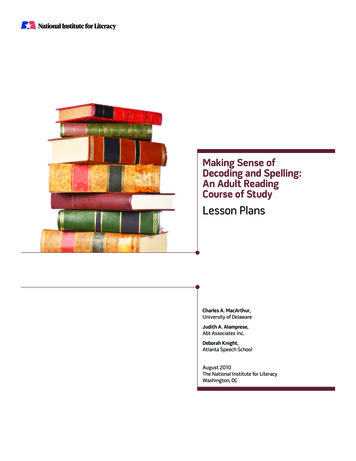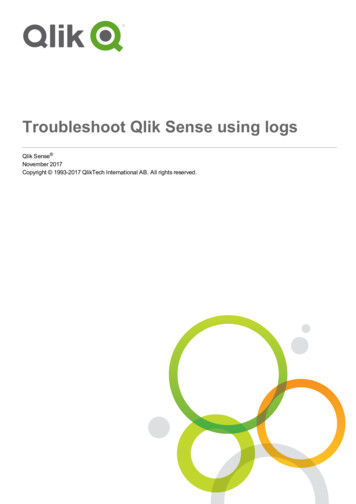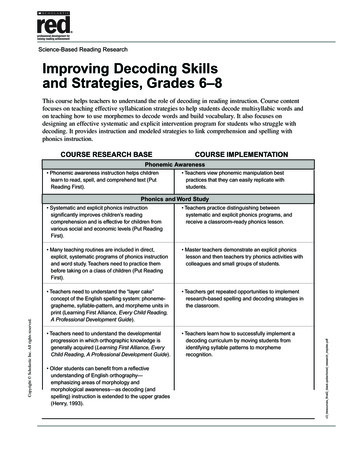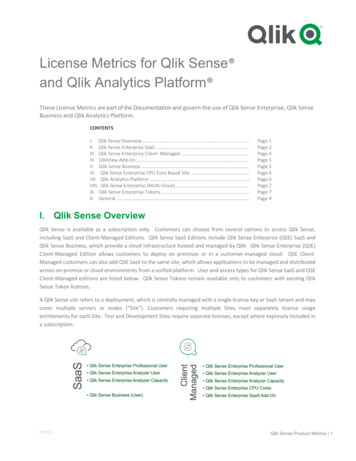
Transcription
Making Sense ofDecoding and Spelling:An Adult ReadingCourse of StudyLesson PlansCharles A. MacArthur,University of DelawareJudith A. Alamprese,Abt Associates Inc.Deborah Knight,Atlanta Speech SchoolAugust 2010The National Institute for LiteracyWashington, DC
The Teachers’ Guide, Lesson Plans, and Learner Activity Book that comprisethe Making Sense of Decoding and Spelling: An Adult Reading Course ofStudy were prepared for dissemination under National Institute for LiteracyContract No. ED-NIL-09-C-0058 with the University of Delaware. Thedevelopment and evaluation of this course of study was supported by a grantto the University of Delaware and Abt Associates Inc. jointly funded by theEunice Kennedy Shriver National Institute of Child Health and HumanDevelopment (NICHD) (5R01HD43798), the National Institute for Literacy(NIFL), and the Office of Vocational and Adult Education (OVAE) of theU.S. Department of Education.The reading course of study materials were written by Charles A. MacArthur,University of Delaware; Judith A. Alamprese, Abt Associates Inc.; andDeborah Knight, Atlanta Speech School. Lynn Reddy served as the contractingofficer’s representative. Patricia Bennett served as the Program Officer. Theviews expressed herein do not necessarily represent the positions or policies ofthe National Institute for Literacy. No official endorsement by the NationalInstitute for Literacy of any product, commodity, or enterprise in thispublication is intended or should be inferred.The National Institute for Literacy, a Federal government agency, is a catalystfor advancing a comprehensive literacy agenda. The Institute bridges policy,research and practice to prompt action and deepen public understanding ofliteracy as a national asset.Daniel Miller, Acting DirectorLynn Reddy, Deputy DirectorAugust 2010The citation for this document should be: MacArthur, C.A., Alamprese, J.A.,& Knight, D. (2010), Making Sense of Decoding and Spelling: An AdultReading Course of Study, Lesson Plans. Washington, DC: The NationalInstitute for Literacy.This document may be downloaded at http://lincs.ed.gov/
PrefaceMaking Sense of Decoding and Spelling: An Adult Reading Course of Study is anevidence-based course of study designed to teach adult learners to decode and spellwords more accurately and fluently. It is designed to be used as one component of acomprehensive adult reading course. The target population for the course is ABElearners at the low-intermediate level (4th-7th grade equivalence level). It contains 30scripted lesson plans. The course begins with a review of basic alphabetic decodingskills and then teaches the most common and useful patterns of English words, andtheir applications in decoding, spelling, and fluent reading. The course was evaluated inan experimental study.NOTE: It is important that instructors have all materials to use this reading courseof study effectively. These Lesson Plans are designed to be used in conjunction withthe other materials that make up the course. Materials for the course include threedocuments and a set of charts: Teachers’ Guide Lesson Plans (This document) Learner Activity Book Charts (in the Appendix of the Lesson Plans and Learner Activity Book)The Teachers’ and Administrators’ Guide presents information about the coreconcepts, design, research base, and implementation of the Making Sense readingcourse of study. It contains guidance for ABE instructors about the knowledge that isneeded to teach Making Sense, the structure and content of the lessons in the course,and the integration of Making Sense within a comprehensive adult reading course. ThisLesson Plans document includes the 30 scripted lessons with related materials whichcan be made into overhead transparencies or PowerPoint slides. The Learner ActivityBook is designed for use by individual learners in conjunction with the lessons; eachlearner should have a copy. The Charts are designed to hang on the wall; copies are inthe Teachers’ Guide and Learner Activity Book. All materials are designed to bedownloaded from the Internet, printed, and copied for use at no cost.AuthorsCharles A. MacArthur is a professor in the School of Education at the University ofDelaware. His major research interests include adult literacy, writing development andinstruction for struggling writers, and strategy instruction. He was the principalinvestigator of the project that developed and evaluated the Making Sense course ofstudy.Lesson Plansi
Judith A. Alamprese is a Principal Associate at Abt Associates Inc. Her research andevaluation interests include adult reading instruction, adult education program quality,interagency coordination, adult basic education and career pathways, and statesystemic change. She was the director of the experimental study in which the MakingSense course of study was evaluated.Deborah Knight is Co-Director of the Rollins Center for Language & Learning at theAtlanta Speech School where she leads a team of coaches who provide comprehensiveprofessional development in literacy for schools. She was an investigator on the projectthat developed the Making Sense course of study.AcknowledgementsMany individuals contributed to the development and evaluation of this course of study.We would like to thank our project officers, Peggy McCardle and Brett Miller fromNICHD, Ricardo Hernandez from OVAE, and Sandra Baxter, Lynn Reddy, and PatriciaBennett from NIFL for their support throughout the project. They were active participantsin coordinating our efforts with our group of research projects. The funding from NIFL todisseminate the results of our work is much appreciated.We also would like to thank the many staff that made the project possible through theirhard work and dedication: Abt Associates Inc.--Cristofer Price and Amanda Parsad forthe statistical analyses, Fumiyo Tao for site recruitment, management, and datacollection, Kathie Mackin and Nancy Brigham for data collection, Daphne Garcia andMeredith Beck for data coding and processing, and University of Delaware researchassistants Allison Golinkoff, Leah Lembo, Katya Midgette, Zoi Philippakos, and XimenaUribe.Finally, we would like to thank the many adult education instructors and learners whocontributed their time and knowledge in providing feedback on the Making Senseinstruction. This feedback was essential to the improvement and success of the course.There are too many to name, but we deeply appreciate their contributions without whichthis work would not have been possible.Lesson Plansii
Table of ContentsScope and Sequence of Lessons1Notes on Using the Lesson PlansUsing the Teachers’ Guide, Lesson Plans, and Learner Activity Book4Formatting Conventions for the Lesson Plans5Lesson Plans (with Materials)Lesson 1: Overview / Introduction1-1Lesson 2: Short a and e in CVC Syllables2-1Lesson 3: Short i, o, and u in CVC Syllables3-1Lesson 4: Syllable Division with CVC Syllables4-1Lesson 5: Prefixes and Suffixes that are CVC Syllables5-1Lesson 6: Review6-1Lesson 7: Long Vowels in VCe Words7-1Lesson 8: Dropping the Final e Prior to a Suffix8-1Lesson 9: Doubling the Final Consonant in CVC Syllables9-1Lesson 10: Variations on the Final-e Pattern10-1Lesson 11: Review11-1Lesson 12: The Cle Pattern12-1Lesson 13: Open Syllables13-1Lesson 14: Stress and Schwa14-1Lesson 15: Review15-1Lesson 16: Sounds of y; Words Ending in y and ey16-1Lesson 17: Changing y to i When Adding a Suffix17-1Lesson 18: Prefixes and Suffixes18-1Lesson 19: Review19-1Lesson 20: Digraph Vowels (ai, ay, ee, ey)20-1Lesson 21: Digraph Vowels (oa, ou, ow)21-1Lesson 22: Digraph Vowels (oi, oy, oo)22-1Lesson Plansiii
Lesson 23: Digraph Vowels (ea)23-1Lesson 24: Syllables with r-Colored Vowels24-1Lesson 25: r-Colored Vowels; Suffixes –or and -ard25-1Lesson 26: Review26-1Lesson 27: Soft and Hard Sounds of c27-1Lesson 28: Soft and Hard Sounds of g28-1Lesson 29: Review29-1Lesson 30: Grand Finale30-1Appendix: ChartsSix Syllable Patterns ChartA-1Spelling Rules ChartA- 2Strategy for Reading Multisyllabic Words ChartA- 3Prefixes ChartA- 4Suffixes ChartA- 5Prefixes and Suffixes BookmarkA- 6Syllables and Strategy Credit CardA- 7Vowel Pronunciation GuideA-8Lesson Plansiv
Scope and Sequence of LessonsLesson 1: IntroductionThe first lesson introduces the course as the study of how the English language worksand teaches the basic concepts of phonemes and syllables with a few exercises.Lessons 2-6: Closed Syllables with Short VowelsThese lessons review the short vowel sounds and basic blending (sounding out)procedures. The closed syllable pattern is explained and multisyllabic words composedof closed syllables are divided and decoded. Affixes that are closed syllables are alsoincluded. The lessons also introduce the first two spelling rules for doubling the final s, f,l in one syllable Consonant Vowel Consonant (CVC) words and spelling the sounds ofk, j, and ch at the end of CVC syllables. The last lesson in this part and every other partis a review.Lesson 2: Short a and e in CVC SyllablesLesson 3: Short i, o, and u in CVC SyllablesLesson 4: Syllable Division with CVC SyllablesLesson 5: Prefixes and Suffixes that are CVC SyllablesLesson 6: ReviewLessons 7-11: Final-e, or Vowel Consonant (VC)e Syllables andRelated Spelling RulesThese lessons introduce the highly reliable VCe, or final-e, pattern for long vowel words.The contrasting spelling rules about dropping the final-e before adding an ending andabout doubling the final consonant in closed syllable words are taught. Syllabificationand affixes are extended to include the new pattern.Lesson 7: Long Vowels in VCe WordsLesson 8: Dropping the Final e Prior to a SuffixLesson 9: Doubling the Final Consonant in CVC SyllablesLesson 10: Variations on the Final-e PatternLesson 11: ReviewLesson Plans1
Lessons 12-15: Open Syllables and consonant-le (Cle) Syllables,Stress and SchwaThese lessons introduce the open syllable pattern with a long vowel. New principles areadded to the strategy for reading multisyllabic words, requiring flexibility when a singleconsonant comes between vowels. The difficult idea of stressed syllables is introducedalong with the concept of the schwa sound. The Cle pattern is also taught.Lesson 12: The Cle PatternLesson 13: Open SyllablesLesson 14: Stress and SchwaLesson 15: ReviewLessons 16-19: Words Ending in y and Related Spelling RuleThese two lessons and review lesson introduce words ending in y and the rule for whento change it to an i when adding endings. More affixes are introduced and the fullstrategy for multisyllabic words is covered.Lesson 16: Sounds of y; Words Ending in y and eyLesson 17: Changing y to i When Adding a SuffixLesson 18: Prefixes and SuffixesLesson 19: ReviewLessons 20-26: Vowel Digraphs and R-colored VowelsThese lessons introduce the most common and reliable vowel pairs. The r-coloredvowels and syllable type are introduced.Lesson 20: Digraph Vowels (ai, ay, ee, ey)Lesson 21: Digraph Vowels (oa, ou, ow)Lesson 22: Digraph Vowels (oi, oy, oo)Lesson 23: Digraph Vowels (ea)Lesson 24: Syllables With r-Colored VowelsLesson 25: Syllables With r-Colored Vowels; Suffixes –or and ardLesson 26: ReviewLesson Plans2
Lessons 27-28: Hard and Soft Sounds of c and gThese lessons introduce the multiple sounds of c and g.Lesson 27: Soft and Hard Sounds of cLesson 28: Soft and Hard Sounds of gLesson 29-30: ReviewThese lessons focus on review of the patterns taught and further practice using thestrategy for reading multisyllabic words. The final lesson reviews the role of phonologyand orthography is reading and spelling words and celebrates the completion of thelessons and the students’ accomplishments.Lesson 29: ReviewLesson 30: Grand FinaleLesson Plans3
Notes on Using the Lesson PlansUsing the Teachers’ Guide, Lesson Plans, and Learner Activity BookThe Teacher’s Guide presents essential information for understanding the content of thelessons. It also includes guidance about how to use the various activities in providinginstruction. It is critical that you read the Teachers’ Guide and use it in preparing yourlessons.The Lesson Plans are scripted to help you in presenting the lessons. However, thescripts are not designed to be read or to confine your teaching. It is important that youreview the lessons thoroughly before teaching them so that you can deliver the contentin a natural way and devote most of your attention to listening and responding to yourlearners. Feel free to expand on the explanations, ask additional questions, provideadditional review, and whatever else is needed to promote adults’ learning.The Lesson Plans frequently refer to the Learner Activity Book. Each learner shouldhave a copy of the Learner Activity Book. Versions of all the activities are included in theLesson Plans with the correct answers indicated in bold.Each lesson includes materials for overhead transparencies or PowerPoint slides. TheMaterials section of the lesson overview guides you on which ones you will need tohave ready and use for each lesson. The materials associated with each lesson arelocated at the end of the lesson. If the material is also in the Learner Activity Book, it isnoted on the material. As suggested elsewhere, you can file the lessons and materialsfor overheads or PowerPoint slides in a notebook for easy access.The lessons also refer to Charts. If possible, you should display these on the wall. TheMaterials section of the lesson works as a reminder of the charts you will need to havedisplayed. The Preparation section of the lesson overview sometimes asks you to putan asterisk on the chart or highlight a section to indicate the content that will be taughtthat day. The charts are included in the Appendix of this volume. The same charts are inthe Learner Activity Book Appendix.The lessons have built-in progress checks to monitor the learners’ understanding of thecontent that is taught. If there is a need to re-teach a lesson, there are additional wordsto use in your instruction.Lesson Plans4
Formatting Conventions for the Lesson PlansThe scripts include symbols to indicate what the instructor should do. The explanation ofthe symbols can be seen in the figure below:Legend ofSymbols Say, Explain, Read, Continue, Pause, Repeat Write Ask Display Point, DrawThe scripts indicate in bold type within parentheses the expected or suggested answersof the learners. The icons and learner responses look like this: Ask, ―Why do we add an s to flame?” (To make it plural.)The scripts frequently include directions to pronounce sounds. A pronunciation guide forthe vowel sounds can be found on the next page. Sounds are indicated by putting theletters within slash marks, like this: Ask, ―Can you think of any other words with the /a/ sound?” (Examples: cat,hat, that, bat)The scripts also include directions to spell out letter patterns. This is represented byletters separated by hyphens, like this: Say, “Go through the letter from camp and underline all of the words that have thedigraph e-a.Lesson Plans5
Lesson PlansLesson Plans6
Lesson 1Overview / IntroductionLesson Overview This lesson is an overview of the entire curriculum. Itintroduces the students to the structural components of Englishlanguage (sound, letter) and sets the purpose for the syllableinstruction lessons.This lesson includes the following parts:- How English Works- Counting Sounds- Recognizing syllables- EtymologyApproximate Time: 40 Minutes.ObjectiveMaterialsTo create a curiosity and an interest in letters, sounds, anddecoding.To provide an introduction and overview of the ty Book, Lesson 1, Activity A: Counting SoundsRecognizing SyllablesActivity Book, Lesson 1, Activity B: EtymologyPreparationLesson Plans1-1
Lesson 1How English WorksEstimated Time: 10 min. Say, “We are beginning a new curriculum to learn how to read and spell wordsaccurately and quickly. Today we are going to learn about the English languageand about what we will study. You won’t know the answers to some of theexercises we do today. Don’t worry about that because when we are finishedwith our work together, you will be able to answer all of the questions andexercises we do today.” Explain, “You will be studying linguistics. Linguistics is the science thatexplains how language works. We will also be studying phonology. Phonologyis the study of the sounds of English. A sound in English is called a phoneme.” Write linguistics on the board. Say, “Linguistics is the science that studies all aspects of language.” Write phonology on the board indented and under linguistics to indicate that itis an area of linguistics. Say, “Phonology is the study of the sounds of language. A phoneme is anotherword for a sound.” Write phoneme on the board under phonology. Ask, “What is similar about the words phonology and phoneme?” (They beginwith phon.) Say, “Right. What do you think phon(e) means?” (speech sound) Say, “Can you think of another word that has phon(e) in it?” (telephone) Say, “Why do you think phone is in telephone?” (We make speech soundswhen we talk on the telephone.) Say, “English words are spelled with letters. How many letters do we have inEnglish?” (26) Say, “Good. We use letters to represent sounds. There are twenty-six letters,but we have more than twenty-six sounds in English.” Ask, “How many sounds are there in English? Take a guess.” (Around 40sounds. It depends on your accent or dialect.)Lesson Plans1-2
Lesson 1 Ask, “So how do we get forty sounds out of twenty-six letters?” (Sometimes wecombine letters to represent a new sound (e.g., s usually represents /s/ andh usually represents /h/. But when we combine s and h in ship, the s-htogether represent /sh/. Vowels can also work together to represent a newsound. O-i in oil represents the sound /oi/.) Say, “There are two basic kinds of sounds in English: vowels and consonants.” Ask, “Can someone name the vowels?” (a, e, i, o, u) Say, “Right. There are also two consonants that also are sometimes vowels: yand w. Let me give you an example. The y in cycle represents the sound of along i. In cow, the o combines with w to serve as a vowel.”Counting SoundsEstimated Time: 10 min. Say, “Let’s try counting the sounds we hear in words. Listen to this word:map.” Ask, “How many sounds or phonemes are in map?” (3) Say, “Listen as I say each of the sounds: /m/ /a/ /p/.” Ask, “Can someone say the sounds in map?” [NOTE: Be sure they are clearlypronouncing each phoneme separately. Tell them to try to say the sound /p/as /p/ rather than /pə/.] Explain, “So, there are three letters and three sounds in map. Sometimes thenumber of letters and sounds don’t match.” Ask, “How many sounds are in the word girl?” (3) Ask, “Can anyone say each of the sounds in girl?” (/g/ /r/ /l/) Explain, “There are four letters, but three sounds in girl.” [NOTE: If studentsare having difficulty with this task, practice a couple more words beforeproceeding with the exercise. Do not expect all students to master segmentingwords into sounds at this point. The objective of this exercise is to introducethem to the relationship between letters and sounds. Try the words, cake (3)and trap (4).] Say, “Now let’s have you count the sounds in words. Look at Activity A in yourbook. Say the words quietly to yourself and write the number of sounds in thespace next to the word.” (You may wish to have students work in pairs.)Lesson Plans1-3
Lesson 1Activity Book, Lesson1, Activity ACounting Sounds1. pig33. bird32. two24. through 35. fix46. tea 27. bomb 38. idea4 Say, “Let’s review the answers.” (Have students pronounce the words andthe sounds in the words.) Ask, “Why does bomb have only three sounds?” (The last b is silent.) Ask, “Why does fix have four sounds?” (The x at the end stands for 2 sounds:/k/ and /s/.) Ask, “Why does tea have two sounds?” (The e-a represents one sound, /ē/.) Ask, “Why does idea have four sounds?” (In this word the e-a represents 2sounds, but you must listen carefully to hear them.) Pronounce idea slowly and distinctly, segmenting each sound.Recognizing SyllablesEstimated Time: 10 min. Say, “We have talked about phonemes. What is a phoneme?” (The soundsthat the letters represent.) Say, “Right. So, /m/ is a phoneme. We can put the phonemes /m/ /a/ /p/together to make the word map. Words are also made up of syllables. If youcan figure out the syllables in a word, you can read almost anything. First,let’s make sure you can hear syllables.” Call on several students by name and ask them how many syllables are in theirnames. If students are having trouble hearing the natural breaks of syllables,ask them to place their hands under their chins. Each time their chin drops,they have said a new syllable. Display the transparency/PowerPoint with antidisestablishmentarianism.Lesson Plans1-4
Lesson 1 Ask, “Can anyone read this word?” Say, “This word has eleven syllables. I’ll write the word by syllables.” Write an ti dis es tab lish men tar i an ism, saying the syllables asyou write them. Ask, “How many of these syllables end with a consonant?” (9) Say, “Great. These nine syllables are closed syllables because they end in aconsonant. How many syllables end in vowels?” (2) Say, “Excellent. For example, ti ends in the vowel i. Knowing how a syllableends gives us a clue as to how to pronounce it. There are only a few ways thatthe vowel in the syllable can be pronounced. We are going to learn aboutsyllables to help you read and spell better. Even though words can be long,they are made up of short syllables that are easier to pronounce and spell. Letme read the word syllable-by-syllable.” Read the word slowly by syllable. Read the word a second time withautomaticity. Say, “So, there are only two kinds of syllables here in one of the longest wordsin English. Once you know the kinds of syllables and how to break words intosyllables, you will have figured out how to read long words. Does anyone wantto try reading this word?” Remove the word from the overhead projector. Say, “Now, I want you to try spelling this word as I say it syllable-by-syllable.Just do the best you can.” Dictate the word syllable-by-syllable. Display the transparency/PowerPointwith the word again and ask students to check their spelling.Lesson Plans1-5
Lesson 1EtymologyEstimated Time: 10 min. Explain, “Etymology concerns the origins of words—what languages they wereborrowed from. English has borrowed words from many languages, butespecially from French, Greek, and Latin. The original vocabulary of English,however, was related to German and was brought to England in the fourth andfifth centuries by Germanic tribes—the Angles, the Saxons, and the Jutes. TheAngles were the dominant tribe, however, and soon Britain was called Angleland, which in time was pronounced “England.” Similarly, the name of thelanguage became “English.” Up until 1066, the English did not have manyFrench words in their language. William the Conqueror came across the EnglishChannel from France and conquered them. The English who were farmerstalked about raising cows and pigs. But the rulers talked about eating the foodthat the Angles, Saxons, and Jutes were raising. So, they used French words.They ate boeuf and porc. These words became beef and pork. This is oneexample of how we borrowed words from other languages. The names of ouranimals come from these Anglo-Saxon languages that are like German. Thenames of many of our meats come from French. Look at Activity B.” Say, “Look at Activity B in your book. Can you guess which languages thesewords were borrowed from?”Activity Book, Lesson 1, Activity BEtymology1. chili, jalapeno, salsaSpanish2. pizza, salami, pepperoniItalian3. hamburger, deli, krautGerman4. chef, romaine, croutonsFrench5. predict, dictation, interdictionLatin Display the transparency/PowerPoint and have students check their work. Say, “Let’s review the activity.” Ask, “What languages did you choose and why?” Ask, “What do you notice about all of the words in number five?” (They allcontain the root word dict, which means to say.)Lesson Plans1-6
Lesson 1 Explain, “Knowing the language a word came from sometimes helps us read andspell that word.” Say, “Today we have begun our study of linguistics. You have begun to learnabout phonology and phonemes, syllable patterns, and etymology. During thiscourse, we will study all of these areas in more depth so that you will becomecompetent, advanced readers, and spellers.”Lesson Plans1-7
Lesson 1Activity Book, Lesson 1, Activity ACounting Sounds1. pig 32. two 23. bird 34. through 35. fix 46. tea 27. bomb 38. ideaLesson Plans4Materials: 1 of 3
Lesson 1Lesson 1Recognizing SyllablesantidisestablishmentarianismLesson PlansMaterials: 2 of 3
Lesson 1Activity Book, Lesson 1, Activity BEtymology1. chili, jalapeno, salsaSpanish2. pizza, salami, pepperoniItalian3. hamburger, deli, krautGerman4. chef, romaine, croutonsFrench5. predict, dictation, interdiction LatinLesson PlansMaterials: 3 of 3
Lesson 2Short a and e in CVC SyllablesLesson Overview This lesson focuses on CVC words that contain the short vowelsounds /a/ and /e/.The lesson includes the following parts:- Document of the Day- New Pattern – short sounds of ‗a‘ and ‗e‘- Segmenting and blending- The CVC pattern- Syllables with CVC- Spelling rule – double ff, ss, ll- Progress Check- Smooth ReadingApproximate Time: 60 MinutesObjectiveMaterialsPreparationLesson PlansTo learn the short sounds of a and e in CVC wordsTo learn the doubling of the endings s, f, l in one syllable CVCwordsSix Syllable Patterns ChartSpelling Rules Chart3 transparencies/PowerPoints:- Document of the Day- Activity Book, Lesson 2, Activity B: Sort the Syllables- Activity Book, Lesson 2, Activity D: Smooth ReadingDisplay the Six Syllable Patterns Chart. Put an asterisk in frontof CVC syllables (or mark it some other way). You will markeach syllable type as you introduce it.Display the Spelling Rules Chart. Put an asterisk in front of thefirst rule for doubling the –f, -s and –l in one syllable CVCwords.2-1
Lesson 2IntroductionEstimated Time: 1 min. Say, ―Today we are working on Lesson 2. In the last lesson, you learned aboutthe sounds, or phonemes, in words and about syllables. Today we are going tolearn about the short vowel sounds of the letters ‗a‘ and ‗e‘. We will alsolearn about a kind of syllable that tells you the vowel has a short sound.‖ Explain, ―In some words and syllables, there is one sound for every letter. Toread and spell these words, you need to be able to hear each of the separatesounds in the word. Some of the words in this lesson will be simple for you toread. We need to practice hearing the sounds in those words because it willhelp you read longer, multisyllabic words.‖Document of the DayEstimated Time: 5 min. Display the Document of the Day transparency/PowerPoint. Read the poster placed in a store window to the students:Ted‘s Batting CagesGrab a bat and a helmet.New customers get two free visits.New Pattern—Short a and eEstimated Time: 5 min. Write bat on the board. Ask, ―How do you pronounce this word?‖ (bat) Ask, ―What is the vowel sound in bat?‖ (/a/) Ask, ―Which word in the Document of the Day has the same vowel sound asbat?‖ (grab) Write grab on the board. The list will look like this:batgrabLesson Plans2-2
Lesson 2 Ask, ―Can you think of any other words with the /a/ sound?” (examples: cat,hat, that, bat) Write the students‘ words on the board. Ask, ―Can you think of any other words that end with a-b?” (examples: flab,nab, cab) Write the students‘ words on the board. Ask, ―What kind of letter follows the a in each word?‖ (a consonant) [NOTE: Ifstudents say the letters b or t, ask them if those letters are vowels orconsonants.] Ask, ―What letters are vowels?‖ (a, e, i, o, u, and sometimes y) [NOTE: Ifstudents mention w, commend them for remembering that w can serve as avowel in combination with other vowels, as in ow in cow.] Explain, ―The rest of the letters are consonants.‖ Write the words bad and bed on the board. Ask, ―What type of letter, consonant or vowel, is in the middle of thesewords?‖ (vowel) Say, ―Bad will be our key word for the sound /a/. Bed will be our key word forthe sound /e/. The sound of the vowel in both of these words is short.‖ Explain, ―I want to explain why we are using key words for short vowel sounds.Short vowel sounds are hard to hear and distinguish. We will use the sameconsonant-vowel-consonant pattern of b d for the key words. We call thispattern the CVC pattern for consonant-vowel-consonant. By keeping theconsonants on either side of the vowel the same, it is easier to concentrate onthe sound that the vowel is making.‖ Say, ―Please repeat the words after me. Say the word, the separate sounds,the word again, and the vowel sound.‖bad, /b/ /a/ /d/, bad, /a/bed, /b/ /e/ /d/, bed, /e/[NOTE: Keep a very rapid pace for the following sequence.] Ask, ―Can someone tell me what the key word for short a is?‖ (bad) Ask, ―Can someone say the sounds in bad?‖ (/b/ /a/ /d/)Lesson Plans2-3
Lesson 2 Ask, ―Can someone tell me what sound the a in bad represents?‖ (/a/) Ask, ―Can someone tell me the key word for the short e?‖ (bed) Ask, ―Can someone say the sounds in bed?‖ (/b/ /e/ /d/) Ask, ―Can someone tell me what sound the e in bed represents?‖ (/e/) Ask, ―Please repeat after me: /a/.‖ (/a/) Say, ―Notice the position of my mouth when I say /a/.‖ Say, ―Now, repeat /e/ after me.‖ (/e/) Ask, ―Can you alternate between the sounds /a/ and /e/?‖ [NOTE: Say /a/followed by /e/ three or four times to model what you will ask students to donext. Exaggerate the position of your mouth.] Say, ―Say /a/ and then /e/.‖ Ask, ―What happens to your mouth when you change from the sound /a/ to/e/?‖ (The mouth moves from being wide open to having more of a smile.) Ask, ―What is the ke
included. The lessons also introduce the first two spelling rules for doubling the final s, f, l in one syllable Consonant Vowel Consonant (CVC) words and spelling the sounds of k, j, and ch at the end of CVC syllables. The last lesson in this part and every other part is a review. Lesson 2: Short a and e in CVC Syllables











